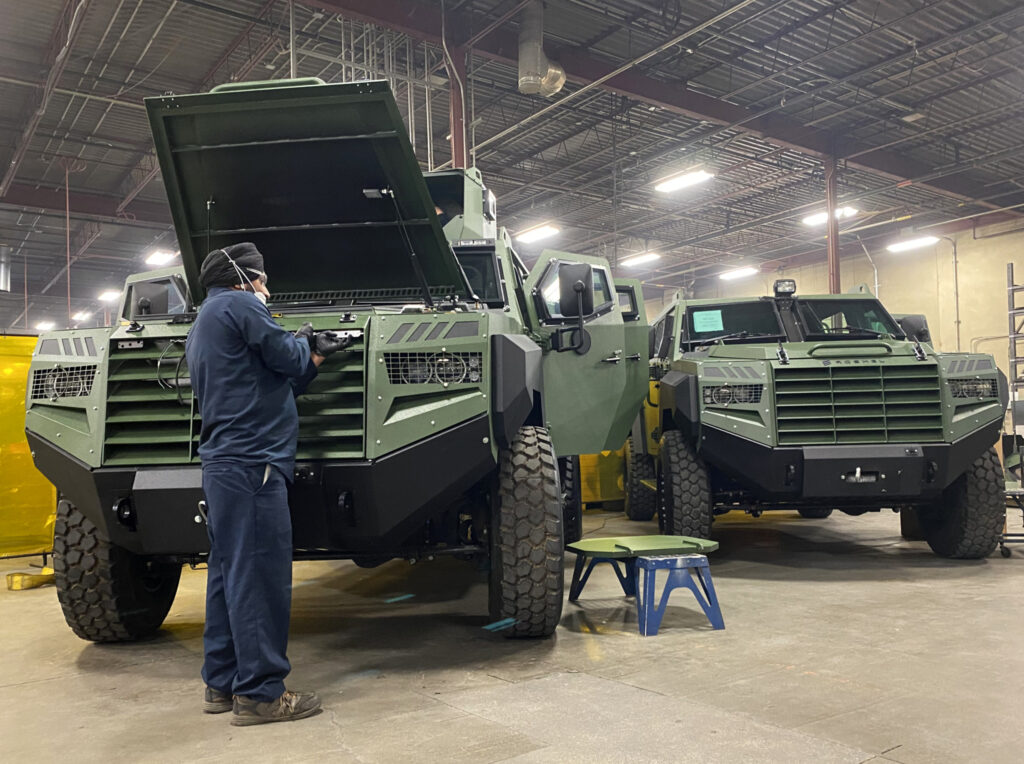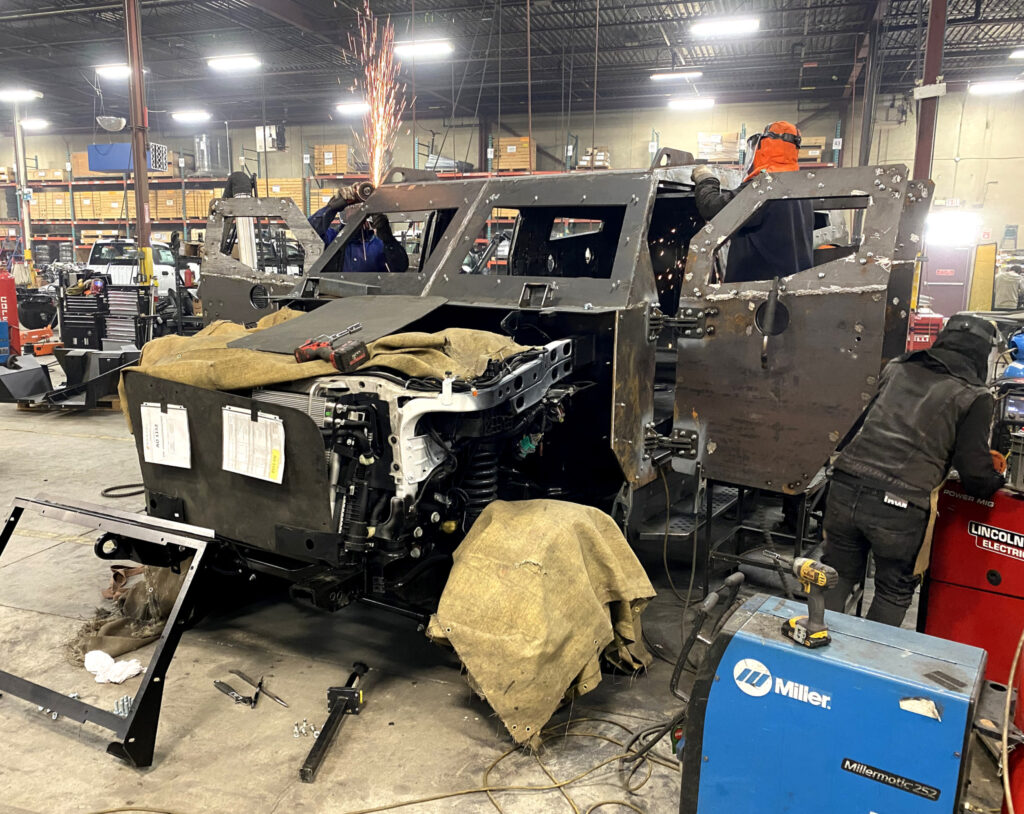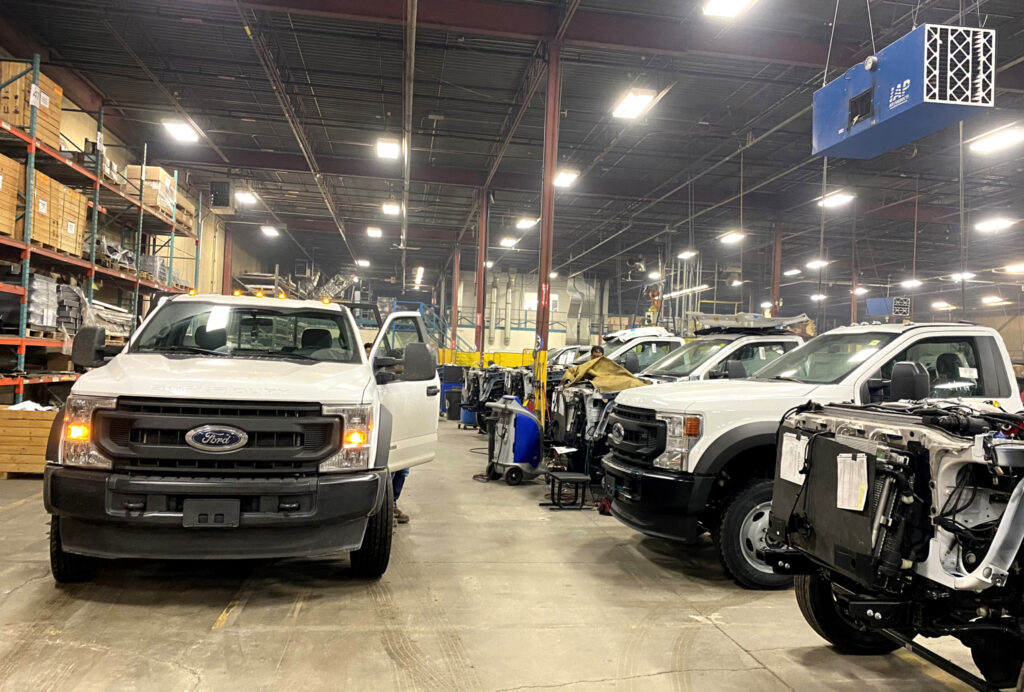Roshel’s Senator comes armored and ready for battle in Ukraine
The F-550 is a workhorse in Ford’s commercial lineup, with prep packages available for high-capacity towing, snowplows, ambulances, and rescue vehicles alike. But Ontario-based Roshel adds features that transform the chassis into something else entirely.
Look no further than the armor plating; the bullet-resistant glass; and the chemical, biological, radioactive and nuclear filtration system. Each plays a role in the Senator armored personnel carriers manufactured for battlefields in Ukraine.
Roshel’s “cash-in-transit” vehicles are a more common sight on Canadian highways, shuttling valuables as diverse as currency and cannabis. But the Senator, launched in 2018, has secured a growing list of buyers including police force tactical units, NASA, and the U.S. Department of Homeland Security. Costa Rica uses it in the fight against drug cartels. And Ukraine’s military is using the armored vehicle to move personnel and support reconnaissance activities.

When Canada committed equipment for the war effort, Ukraine Defense Minister Oleksii Reznikov requested the model by name. His country’s military already had Senators on the ground and in the fight.
A single-source $90-million contract was inked for 200 more.
“Today, the Ukrainian army needs 200 Senator APCs more than ever,” Ukraine President Volodymyr Zelenskyy tweeted when the Canadian deal was announced. “Together we are moving towards victory!”
Other allies are adding to the total as Roshel’s 400 personnel work three shifts, around the clock, to meet the growing demand.
“We have a combat-proven, field-proven solution with over 200 vehicles right now in Ukraine and another 300 coming in the next few months. By the end of this year we’re planning to deliver over 1,000 vehicles,” Roshel CEO Roman Shimonov said in an interview with TruckNews.com.
Military-grade vehicle hardware
This is no typical work truck, of course. Related military hardware includes armor plating; a fire suppression system; and sensors to detect radiation, gas, and fire. Ballistic windshields that are 100 mm thick are mounted from outside the vehicle, and are larger than the openings so they won’t punch inward when exposed to a blast. Gun ports can only be opened from the inside, unlike than competitive models that allow the all-important barriers to be lifted with a magnet. Door stoppers and a rear step can also be opened with a kick rather than exposing hands.
“The idea of the vehicle is to make the passenger as safe as possible and to be able to escape from the place it’s attacked.”
Each feature is pushed to the limits, too. While every truck manufacturer tests vehicles against noise, vibration and harshness, souvenirs of other tests conducted for Roshel include displays of bullet-ridden armor plates and windshields in the boardroom and lobby.
“In a combat zone it’s not a highway,” Shimonov says. “It’s not normal terrain.”

There is little “normal” about the custom manufacturing activities either, with a broad array of components and systems produced in house.
It’s a strategy that shielded the business from some of the supply chain issues that have disrupted other manufacturers. When lead time for wheels expanded to two years, for example, Roshel brought the work into the Mississauga plant.
“One of the differences between us and other companies is that we are doing the whole process in house. We’re not subcontracting anything to anyone,” Shimonov adds, pointing to a production cell as it cut metal into useable components.
“We’re not an upfitter. Upfitters, they buy components. They take a ready vehicle and they integrate different components without manufacturing,” he says. “We build vehicles from scratch. We design components and devices including electronic components that we build in house – including the printing of PC boards, and creating harnesses, and writing the software.”

Powertrain and suspension changes
A Ford-550 chassis may sit underneath, but the finished vehicle is hardly a stock unit, even if the Canada Safety Mark deems it roadworthy.
While the Senator is powered by a standard 6.7-liter V8 turbodiesel, for example, the engine used in Ukraine is downgraded to a Euro 2 emissions standard rather than the off-the-shelf Euro 5 offering. “So you can use a high-sulfur dirty diesel, especially in the combat zone where you cannot necessarily source clean diesel,” Shimonov explains.
Supporting everything from below, the coils, leaves, sway bars, and shock absorbers are all upgrades. The end result helps bring the net payload to 6,000 lb. after the vehicle is armored.
“It’s not only about the vehicles,” he adds, referring to electronic components. Shimonov can’t discuss the specific features there, but acknowledges that the Senator can draw on lessons learned with Roshel’s customized fleet management system that covers logs, maintenance, routing, scheduling and messaging.
“A lot of military components are integrated already in the commercial one. And the distance – the gap – between the commercial and military [systems] is getting much closer to one another.”
Cybersecurity needs exist in civilian work and war zones alike.
Supporting vehicles in a war zone
Sales and support activities offer unique challenges in their own right.
There are no Senators on dealership lots. Each is built after responding to an RFP and securing a permit issued by the Department of Foreign Affairs. (“If you have the right price, the right performance, the right product, you don’t need any sales efforts to convince anyone.”)
Then there’s the matter of offering parts and service support in a war zone.
“It’s not a simple task,” the CEO concedes. “You need to have people that can move. They need to have the skills to be able to read diagrams, the blueprints. They need to have the access to the parts that we send them and we get on the ground. They need to be able to move in the combat zones and they need to have access to the military bases.”
Connections to Ukraine
Many of the Ontario employees have their own connections to the country. Eighty of them are from Ukraine, and are supporting the war effort even if they can’t qualify for military service in their homeland.
“They are still Ukrainians. They want to contribute to their country. And besides making good money in working with us, they contribute by building vehicles that they see on TV,” Shimonov says. One employee’s mother was evacuated on a Senator that he helped to build.
The business has clearly come a long way since its humble beginnings in 2016, when the entire operation fit in a small office. Shimonov, a former member of the Israeli army’s intelligence branch, sold a service contract that he had following military service. His first idea after immigrating to Canada was to resell products. But now he oversees three production facilities covering hundreds of thousands of square feet.
In the years up to February 2022, the focus was on producing the cash-in-transit vehicles for clients such as Brinks, Garda, Malca-Amit, and Fortress. Ryder just took delivery of its first batch. And last year Roshel produced more than 1,000 vehicles overall.
That business continues, even if existing clients have embraced delays so the military equipment can get where it needs.
Roshel’s next product to be unveiled in early 2024 will be a battery-electric Final Mile step van, he says, stressing that it will be built from scratch rather than mounting components on top of another supplier’s “skateboard”. The motor and battery management system will be outsourced, but everything else will be made in house.
“We already have pre-orders,” he says, noting the business is already building vehicles based on Ford’s E-Transit for clients such as Garda World and Malca-Amit.
“It’s only a matter of time until everyone will move to the electric vehicle world ,and we want to be a part of it. We have the knowledge. We have the expertise.”
Have your say
This is a moderated forum. Comments will no longer be published unless they are accompanied by a first and last name and a verifiable email address. (Today's Trucking will not publish or share the email address.) Profane language and content deemed to be libelous, racist, or threatening in nature will not be published under any circumstances.
Awesome